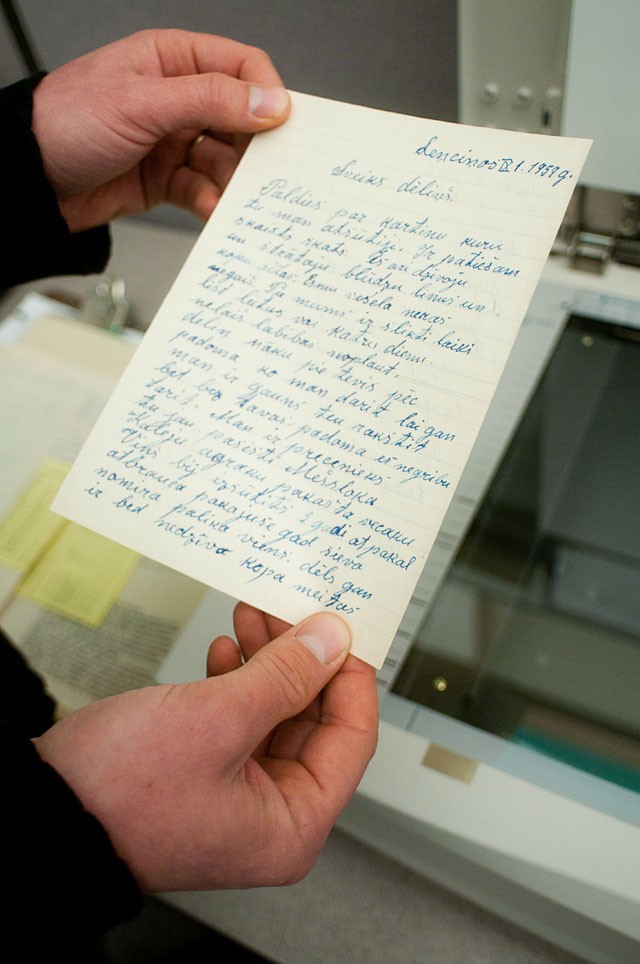On Feb. 3, 1957, Latvian citizen Anna Paikens wrote somberly to her son, who had recently moved to Minneapolis: âÄúYou know that well that I am lonely. When I receive your letter it is like a sun after rain for me.âÄù
She went on to describe her loneliness, and to remind Edward to send gifts back home in time for little sister MaijaâÄôs birthday.
âÄúDo you have churches there? Are you married or just engaged? Did you also have a wedding ceremony?âÄù she wrote in an earlier letter. âÄúDonâÄôt take offense, everything interests me about your life. I want to know everything.âÄù
Later, after Edward has married, Anna shows that certain traits of a mother are timeless: âÄúDear son it would be about the time to think about children. You will be 40 years old.âÄù
The PaikensâÄô correspondence is just one part of âÄúA Heart Connects Us: Immigrant Letters and the Experience of Migration,âÄù a digitization program at the University of Minnesota with letters dating back to 1850.
Since the Digitizing Immigrant Letters program kicked off last spring, about 40 letters have been digitized, with more to come. The projectâÄôs purpose is to establish an international connection among archives, program developer Donna Gabaccia said. The letters were written by, and to, European immigrants in North America between 1850 and 1970.
The digitizing was carried out during the spring 2010 semester, program developer Haven Hawley said. The letters came from the International Immigration History Research Center database in Elmer L. Anderson Library.
The IHRC has aggregated hundreds of original and microfilm copies of the letters through research and donations from the families and communities, Hawley said.
The project is digitizing sections of letters and arranging them to give readers the opportunity to âÄúlook at both sides of the correspondence,âÄù Gabaccia said.
Students and researchers involved in the project were chosen based on their fluency in English and their native language, which they used to translate the letters, Hawley said.
The letters are scanned, transcribed, translated and placed on a Web archive. Some were difficult to read, Hawley said.
Some correspondences were as big as 250 letters back-and-forth, and had to be scaled down to seven letters that were the most relevant.
It is an âÄúemotional process,âÄù said Ilze Garoza, a University comparative and international developmental education graduate student. The Latvian language expert for the project studied the 250-letter correspondence between Edward and Anna Paikens.
These letters are included in an interactive Web page where the public can upload letters and lesson plans for teachers. An exhibition is scheduled to open in February in the Elmer L. Anderson Library.
Hawley said the Hmong correspondences are a special part of the program. The Hmong population has a tradition of oral storytelling, she said, so they sent each other oral letters via more modern video cassettes.
Gabaccia hopes the program helps people receive a better understanding of what emigrants left behind, and how people maintained emotional connections.
Undergraduate Kao Chuoa Vue has a personal connection with the collections.
As a first-generation Hmong student, she said she relates to the contents of the letters. Her parents contributed to the oral letters exhibition, and Vue participated by reading and translating some of the European letters.
âÄúBecause we live in the times of cell phones and e-mail, we tend to think, âÄòHow could people keep in touch with each other?âÄôâÄù she said. âÄúBut the millions and millions of letters that we know are out there prove to us that they did want to stay in touch.âÄù
âÄúThey basically lived their lives through letters,âÄù Garoza said, remembering the letters she translated between the Paikens mother-and-son duo.
Most of the IHRC collections are between European correspondents, Gabaccia said, although the program is currently working with Chinese letters as well.
The project is âÄúto remind us that the desire to stay in touch is a universal one,âÄù Gabaccia said.
She said the letters had a broad range of education level, but the one aspect that remained the same was the expression of emotion.
âÄúIt is almost like the language is captured in time,âÄù Hawley said.
U digitizes early immigrant letters home
The U is putting a collection of hundreds of letters online.

Image by Jason Kopp
Daniel Necas displays an immigrant letter on Monday in the Immigration History Research Center (IHRC) in the Elmer L. Anderson Library. The IHRC is working to digitize, translate, and interpret thousands of letters exchanged between immigrants and their loved ones between 1850 and 1970.
Published December 7, 2010
0

